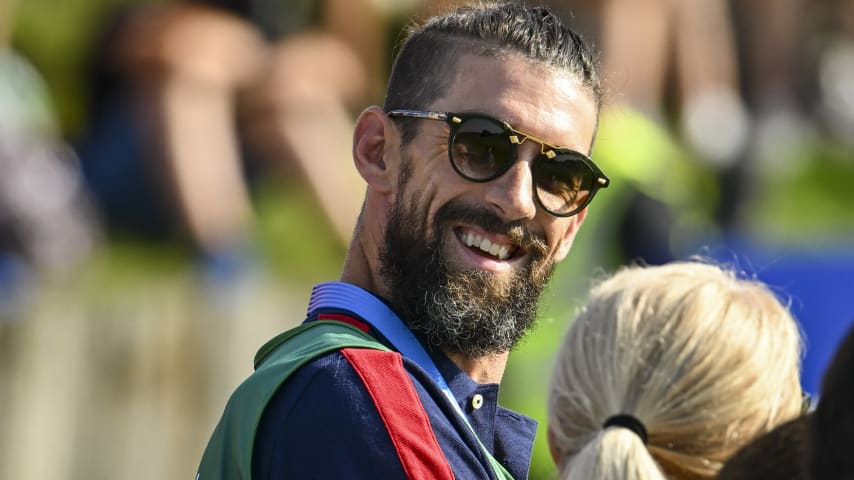PGA TOUR chief agronomist talks Olympics, Le Golf National, ‘Buck Rogers’ technology
6 Min Read

Drone flyover of closing hole at Le Golf National
Written by Lisa Antonucci
Editor’s note: Ahead of the 2024 Olympic golf competitions, PGA TOUR Vice President of Competitions Agronomy Paul Vermeulen sat down to talk about his role on the Olympics agronomy team at Le Golf National. This interview has been lightly edited for brevity and clarity.
PGATOUR.COM: When it comes to the Olympics, how do you approach a project of this magnitude?
Paul Vermeulen: From an agronomy perspective it’s very much like the approach to any event on the PGA TOUR, and specifically, any new venue on the PGA TOUR – a lot of the early discussions revolve around just building a rapport with the individuals that you're going to be working with during the event, getting to know one another, getting to know what the guidelines for golf course maintenance are in that particular portion of the map because it's different all over. And then studying the weather patterns, studying the specific grass types that they are maintaining at that facility, and then being of service to the superintendent in every which way possible.
PGATOUR.COM: How many people are on the agronomy team for the Games?
Vermeulen: The agronomy team totals 100 – 40 in the core group, the staff at Le Golf National, and 60 support staff we bring in to help out during the competition.
PGATOUR.COM: That sounds like a lot! Is this more or less than normal for a “regular” tournament?
Vermeulen: There is no standard. Essentially you have one hour and 45 minutes to two hours in the morning to get all the work done, and then another hour and 45 minutes to two hours after play concludes. So, you've got two small windows to complete all of your routine maintenance activities. And when you reach the actual competition days, you increase the frequency of all mowing procedures. So basically, you double the number of times the greens are mowed, the tees are mowed, the fairways are mowed, the bunkers are raked.
PGATOUR.COM: Having the men's competition and women's competition back-to-back means 13 straight days of practice rounds and/or competition with no time to recover. How do you prepare a golf course for this kind of nonstop action?
Vermeulen: You start with where you want to finish. You know where you want to be on the last day of competition, and then you work your way back from there. So, in terms of managing the amount of moisture on the golf course, managing the nutrition of the golf course, managing your staff, their hours, mowing frequency. You optimize playing conditions throughout that continuous period with your eye on the last day to kind of bring it to a crescendo as best you can. Now, Mother Nature is a partner, and she's not always cooperative, so you have to bend to her will.

A member of the agronomy staff rolls the 18th hole green during practice for the Olympic men’s golf competition on day three of the Olympic Games. (Keyur Khamar/PGA TOUR)
PGATOUR.COM: So how is Mother Nature cooperating?
Vermeulen: The season has been wetter than normal. So, the golf course is growing vigorously, and it's quite green versus the look during a dry season when the fairways, which are the irrigated portions, and the greens and the tees, which are also irrigated, are green and vibrant and the exterior rough areas are in a state of semi-dormancy. This year, everything is actively growing. There are benefits to that, and we will happily accept them. The golf course is in good condition.
PGATOUR.COM: What innovative technology is being used at Le Golf National? I read that in the runup and during the Games, mowers will be equipped with sensors to monitor soil moisture, and that these interventions and watering can be measured with even greater precision.
Vermeulen: It sounds like “Buck Rogers”-type stuff, right? But really, the technology has been with us for decades. In the last five years or so, if you’ve seen drought monitoring maps, they are generated from taking soil moisture measurements from satellites rotating the planet. They take a measurement about every 30 miles, and then they put together a map that covers the continent. That technology has been improved such that we can mount a sensor on the tail end of a fairway mower and take soil moisture readings every foot and a half as the mower goes from tee to green. And then we can collect all the measurements and produce a map showing exactly where we have adequate soil moisture and where we will have to provide some additional moisture.
As for watering… irrigation technology has leapt forward in the last couple of decades, largely due to computer controls. Instead of using a timer that has a unit of say, one minute, you can use a digital computer that has a unit of one second. So, if you only need 15 seconds of water, you don't have to put on a minute, you can just put on 15 seconds, to conserve water.

(Keyur Khamar/PGA TOUR)
It's right-out-of-the-box new; Le Golf Nationale wants to be at the forefront of using this technology, so we scan the fairways every day, and we can see exactly how much moisture has been lost through evaporation, and we can program the irrigation system to replace that lost quantity of water, or use our staff and support staff to target specific areas with handheld hoses. It's going to be, I think, the most sophisticated effort to manage golf course irrigation to date.
PGATOUR.COM: Le Golf National has gone from internal combustion to electric mowing equipment. Has it done anything else special in its preparation as far as minimizing or eliminating chemicals and supporting pollinators?
Vermeulen: Le Golf National has already developed wildlife habitat areas and migratory corridors for wildlife so that they can move throughout the property undisturbed. We just basically work from that platform and take into consideration the competition schedule and all the other activities that are going to be ongoing across the property. So, it's really doing more of what they've already been doing and not disturbing the gains that they have already made to date.

(Keyur Khamar/PGA TOUR)
PGATOUR.COM: What do you really love about Le Golf National and what do you think makes this venue so special?
Vermeulen: For me, it's the architectural theme of the property. The fact that they have folded the land in a manner that creates high elevation, low elevation and close proximity, and then created areas for bodies of water to be sustainable – I think that's all a big part of my overall enjoyment of the property. It's not a square plot of land that is the same elevation, all mowed at the same height with a couple of landscapes, landscape materials scattered throughout the rough area. It's unique.
I think that the other part that's so impressive to me, and it's something that you may not notice when you visit the property, is that it's a former dump site. It was a disposal area for construction rubble. So those mounds are piles of material that were deposited on the property for permanent storage, and then molded and turned into what you see today that has function for the game of golf and function for environmental sustainability. Quite extraordinary. It's a manmade utopian experience. …
My accolades go to the staff at Le Golf Nationale for doing everything in advance. They've done a great job of investing in their future through conservation, through investing in their infrastructure – the irrigation system, the drainage system, the equipment inventory, and most importantly, their staff. They actually have individuals on the staff who are dedicated to accomplishing a sustainable future for golf course management. That's where I applaud them.












